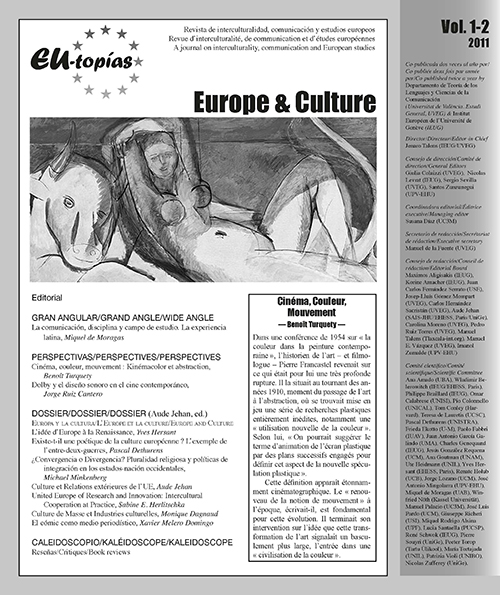Dolby y el diseño sonoro en el cine contemporáneo
DOI:
https://doi.org/10.7203/eutopias.1.18438Parole chiave:
Dolby, diseño sonoro, sonido cinematográfico, Nuevo Hollywood, Walter Murch, Ben Burtt. Abstract
Abstract
Para el sonido cinematográfico, el período que recorre los últimos cuarenta años ha significado una etapa de avance continuado. Un progreso que se ha manifestado no solo a nivel técnico o estético, sino también en el creciente peso específico de la banda sonora dentro del proceso de diseño y producción de filmes en nuestros días. Este artículo analiza con detenimiento la influencia decisiva de las tecnologías Dolby en estas transformaciones, al tiempo que esboza algunas perspectivas futuras de evolución
 Downloads
Downloads
 Riferimenti bibliografici
Riferimenti bibliografici
BECK, Jay (2008). “The Sounds of ‘Silence’. Dolby Stereo, Sound Design, and The Silence of the Lambs”, en Jay Beck y Tony Grajeda (eds.), Lowering the Boom. Critical Studies in Film Sound, , pp. 68-83. Baltimore: University of Illionis Press.
CHION, Michel (1993). La audiovisión. Introducción a un análisis conjunto de la imagen y el sonido. Barcelona: Paidós.
Dolby (2010). “The Evolution of Dolby Film Sound” [En línea]. Disponible en <http://www.dolby.com/uploadedFiles/zz-_Shared_Assets/English_PDFs/ Professional/53_ EvolutionOfSound.pdf>. [Consultado 25 enero 2011].
HANDZO, Stephen (1985). “A Narrative Glossary on Film Sound Technology”, en Elisabeth Weis y John Belton (eds.), Film Sound, pp. 383-426. New York: Columbia University Press.
IOSONO (2010). “The Technology” [En línea]. Disponible en <http://www.iosono-sound. com>. [Consultado 20 enero 2011].
KASSAB, John (2009). “Report to investigate creative, technical and workflow innovations in post-production film sound in London, New York, San Francisco, Los Angeles and Wellington” [En línea]. Disponible en <http//www.churchilltrust.com.au/site_media/fellows/ 2009_Kassab_John.pdf>. [Consultado 20 enero 2011].
MANCINI, Marc (1985). “The Sound Designer”, en Elisabeth Weis y John Belton (eds.), Film Sound, pp. 361-368. New York: Columbia University Press. Publicado originariamente como «Sound Thinking» en Film Comment 19.6 (Noviembre- Diciembre 1983), pp. 40-43, 45-47.
MURCH, Walter (2000). “Stretching Sound to Help the Mind See” [En línea]. Disponible en <http://filmsound.org/murch/stretching.htm>. [Consultado 21 enero 2011].
MURCH, Walter (2007). “Touch of Silence”, en Larry Sider, Diane Freeman y Jerry Sider (eds.), Soundscape. The School of Sound Lectures 1998-2001, pp. 83-102. London: Wallflower Press.
PETROSKY, Max (2010). “Tron Wiki: Frank Serafine Interview” [En línea]. Disponible en <http://tron.wikia.com/ wiki/Tron_Wiki:Frank_Serafine_ Interview>. [Consultado 21 enero 2011].
SCHREGER, Charles (1985). “Altman, Dolby, and the Second Sound Revolution”, en Elisabeth Weis y John Belton (eds.), Film Sound, pp. 348-355. New York: Columbia University Press. Publicado originariamente en Film Comment, 14, nº 5 (Septiembre-Octubre 1978). Título original: “The Second Coming of Sound”.
SERGI, Gianluca (1999). “The Sonic Playground. Hollywood Cinema and its Listeners” [En línea]. Disponible en <http://www.filmsound.org/articles/sergi>. [Consultado 24 enero 2011].
SERGI, Gianluca (2004). The Dolby era. Film Sound in Contemporary Hollywood. Manchester & New York: Manchester University Press.
SHATZ, Leslie (2001): “The Dolby Film Sound Revolution: Looking Back and Looking Forward with Audio Pioneer Ioan Allen” [En línea]. Disponible en <http://www. editorsguild.com/v2/magazine/Newsletter/SepOct01/ioan_allen_one.html>. [Consultado 24 enero 2011]. Reimpreso de The Motion Picture Editors Guild Magazine. Vol. 22, No. 4 – September/October 2001.
TURNER, Nick, y Tom Giles, (eds.) (2010). “Pixar Gets Dolby to Invent ‘Rain of Sound’ to Match 3D Movies” [En línea]. Disponible en <http://www.sfgate.com/cgi-bin/ article.cgi?f=/g/a/2010/05/22/bloomberg1376-L2SL460YHQ0X-1.DTL>. [Consultado 12 junio 2010].
WHITTINGTON, William (2007). Sound Design and Science Fiction. Austin: University of Texas Press.
Downloads
Pubblicato
Come citare
-
Abstract543
-
PDF (Español)404
Fascicolo
Sezione
Licenza
![]()
Tutti i contenuti pubblicati in EU-topías. Rivista di interculturalità, communicazione e studi europei è concesso in licenza Creative Commons Attribution-NonCommercial-ShareAlike 4.0. Il testo completo della licenza è disponibile all’indirizzo http://creativecommons.org/licenses/by-nc-sa/4.0
Essi possono essere copiati, utilizzati, diffusi, trasmessi e visualizzati pubblicamente, a condizione che ciò avvenga:
- Viene citata la paternità e la fonte originale della pubblicazione (rivista, editore e URL dell’opera).
- Non vengono utilizzati per scopi commerciali.
- L’esistenza e le specifiche di questa licenza d’uso sono menzionate.



